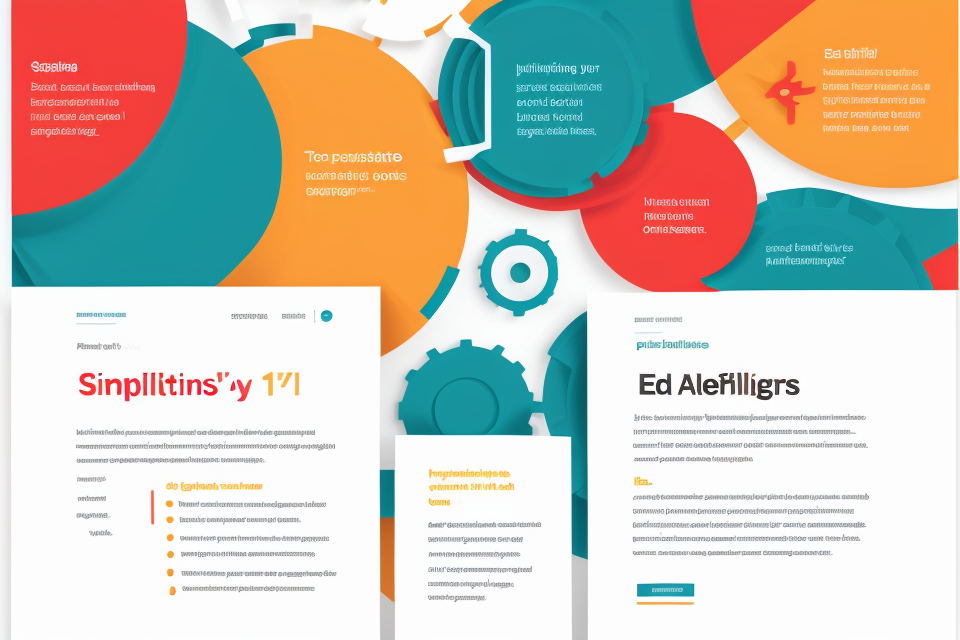
In today’s fast-paced digital world, software performance is a critical factor that determines the success of any application. As software applications become more complex, optimizing their performance has become essential to deliver a seamless user experience. In this article, we will explore the various areas where optimization techniques can be applied to maximize software performance. From code optimization to database optimization, we will delve into the best practices and techniques that can help improve the speed, efficiency, and scalability of your software applications. So, buckle up and get ready to learn how to optimize your software for better performance!
Understanding Software Optimization
Why is software optimization important?
Software optimization is crucial for a variety of reasons, all of which are aimed at improving the overall performance of software applications. Some of the most important reasons why software optimization is important are:
- Improving performance: By optimizing software, you can improve its performance and make it run faster and more efficiently. This is particularly important for applications that are used by a large number of users, as optimizing the software can help to reduce the load on the server and improve the user experience.
- Reducing resource usage: Optimizing software can also help to reduce the amount of resources that it uses, such as memory and CPU usage. This can help to improve the overall stability of the application and reduce the risk of crashes or other issues.
- Enhancing user experience: Finally, optimizing software can help to enhance the user experience by making the application more responsive and easier to use. This can help to increase user satisfaction and reduce the likelihood of users abandoning the application in favor of a competitor.
Types of software optimization
When it comes to optimizing software performance, there are several areas that require attention. The following are some of the most common types of software optimization:
- Code optimization: This refers to the process of improving the efficiency of code by identifying and eliminating any unnecessary or redundant instructions. This can be achieved through techniques such as loop unrolling, constant propagation, and instruction scheduling.
- Memory management: Memory optimization involves reducing the amount of memory used by a program and improving the efficiency of memory allocation and deallocation. This can be achieved through techniques such as garbage collection, memory paging, and memory compression.
- Database optimization: Database optimization involves improving the performance of databases by reducing the amount of data that needs to be retrieved and processed. This can be achieved through techniques such as indexing, query optimization, and data caching.
In addition to these types of software optimization, there are many other techniques that can be used to improve software performance. These include profiling, debugging, and benchmarking, among others. However, by focusing on the three main types of software optimization discussed above, developers can often achieve significant improvements in software performance without having to resort to more complex techniques.
Identifying Areas for Optimization
Software optimization is crucial for improving the overall performance of software applications. Common performance bottlenecks include inefficient algorithms, large data sets, and resource-intensive operations. Analyzing software performance using profiling tools, benchmarking, and performance monitoring can help identify areas for optimization. To set optimization goals, developers should identify pain points, establish KPIs, and prioritize areas for improvement. Implementing optimization techniques such as code optimization, memory management techniques, and database optimization techniques can help improve software performance.
Common performance bottlenecks
In software development, performance bottlenecks can significantly impact the efficiency and effectiveness of the application. These bottlenecks can be caused by a variety of factors, including inefficient algorithms, large data sets, and resource-intensive operations. Understanding these common performance bottlenecks is essential for identifying areas where optimization techniques can be applied to improve the overall performance of the software.
Inefficient Algorithms
Inefficient algorithms can be a significant source of performance bottlenecks in software applications. Algorithms that are poorly designed or have inefficient data structures can lead to slow execution times, increased memory usage, and decreased overall performance.
To identify inefficient algorithms, developers can analyze the code for areas with high computational complexity, such as nested loops or recursive functions. Profiling tools can also be used to identify specific algorithms that are causing performance issues.
Once identified, developers can implement optimization techniques such as improving algorithm efficiency, reducing the number of computations, or using more efficient data structures.
Large Data Sets
Large data sets can also be a significant source of performance bottlenecks in software applications. Processing large amounts of data can be resource-intensive and can cause delays in application performance.
To identify areas where large data sets are causing performance issues, developers can analyze the code for areas where data is being read or written in large quantities. Profiling tools can also be used to identify specific areas of the code that are causing performance issues.
Once identified, developers can implement optimization techniques such as data partitioning, caching, or using more efficient data structures to improve the performance of the application.
Resource-Intensive Operations
Resource-intensive operations, such as I/O operations or network requests, can also be a significant source of performance bottlenecks in software applications. These operations can cause delays in application performance and can impact the overall efficiency of the application.
To identify areas where resource-intensive operations are causing performance issues, developers can analyze the code for areas where resource-intensive operations are being performed. Profiling tools can also be used to identify specific areas of the code that are causing performance issues.
Once identified, developers can implement optimization techniques such as reducing the number of resource-intensive operations, using asynchronous I/O, or optimizing network requests to improve the performance of the application.
Analyzing software performance
Software performance can be analyzed using profiling tools, benchmarking, and performance monitoring.
- Profiling tools:
- These tools help identify performance bottlenecks by providing information about the code execution, such as the time spent in each function or method.
- Examples of profiling tools include Visual Studio’s profiler, Gprof, and Java VisualVM.
- Benchmarking:
- Benchmarking involves comparing the performance of a software system with other similar systems or with its own previous versions.
- It helps identify areas for optimization by comparing the performance of different algorithms or data structures.
- Examples of benchmarking tools include JMeter, Apache Bench, and Google’s benchmarking tools.
- Performance monitoring:
- Performance monitoring involves collecting and analyzing data about the performance of a software system over time.
- It helps identify performance issues before they become critical and helps optimize the system’s resource usage.
- Examples of performance monitoring tools include Nagios, Zabbix, and Prometheus.
In summary, analyzing software performance is an essential step in identifying areas for optimization. Profiling tools, benchmarking, and performance monitoring are some of the techniques that can be used to analyze software performance. By using these techniques, developers can identify performance bottlenecks and optimize their software systems to improve their performance.
Setting optimization goals
- Identifying pain points: Pain points refer to areas of the software where users are experiencing slow performance or encountering errors. These areas can be identified through performance monitoring tools, user feedback, and testing. Identifying pain points is crucial because it helps to prioritize which areas of the software need optimization the most.
- Establishing KPIs: Key Performance Indicators (KPIs) are metrics that are used to measure the performance of the software. Examples of KPIs include response time, throughput, and availability. Establishing KPIs helps to define what good performance looks like and sets a benchmark for the software. It also helps to identify areas of the software that are not meeting the desired performance levels.
- Prioritizing areas for improvement: Once the pain points and KPIs have been identified, the next step is to prioritize which areas of the software need optimization the most. This can be done by using a variety of techniques such as cost-benefit analysis, risk assessment, and user feedback. Prioritizing areas for improvement ensures that the optimization efforts are focused on the areas that will have the most significant impact on the software’s performance.
Implementing Optimization Techniques
Code optimization techniques
Loop unrolling
Loop unrolling is a technique that involves replacing a loop with a series of repeated instructions. This can improve performance by reducing the overhead associated with the loop itself, such as the setup and teardown of loop variables.
To implement loop unrolling, identify loops in the code that execute a large number of iterations, and then replace the loop with a series of repeated instructions. For example, a loop that calculates the sum of an array of numbers can be replaced with a series of additions that add up the elements of the array.
However, it is important to note that loop unrolling can increase the code size, which can have a negative impact on performance. Therefore, it is important to balance the benefits of loop unrolling against the increased code size.
Array processing
Array processing is a technique that involves performing operations on arrays of data. This can improve performance by reducing the number of iterations required to process the data.
To implement array processing, identify operations that can be performed on arrays of data, such as sorting or searching. Then, implement these operations using array processing techniques, such as sorting algorithms or binary search.
Array processing can improve performance by reducing the number of iterations required to process the data. However, it is important to note that array processing can also increase the code size, which can have a negative impact on performance. Therefore, it is important to balance the benefits of array processing against the increased code size.
Function inlining
Function inlining is a technique that involves replacing a call to a function with the code of the function itself. This can improve performance by reducing the overhead associated with function calls, such as the setup and teardown of function call frames.
To implement function inlining, identify functions that are called frequently in the code, and then replace the function calls with the code of the function itself. For example, a function that performs a complex calculation can be replaced with the code that performs the calculation directly.
However, it is important to note that function inlining can increase the code size, which can have a negative impact on performance. Therefore, it is important to balance the benefits of function inlining against the increased code size. Additionally, function inlining can also make the code more difficult to understand and maintain, which should be taken into consideration when deciding whether to use this technique.
Memory management techniques
Garbage collection
Garbage collection is a technique used to automatically manage memory allocation and deallocation in a program. It involves periodically scanning the memory for objects that are no longer in use and deallocating their memory. This technique is useful for languages that support dynamic memory allocation, such as Java and Python.
One of the advantages of garbage collection is that it eliminates the need for manual memory management, which can be error-prone and time-consuming. However, it can also introduce performance overhead, as the garbage collector needs to periodically scan the entire memory space to identify and deallocate unused objects.
Memory pooling
Memory pooling is a technique used to optimize memory allocation and deallocation in a program. It involves creating a pool of memory objects that can be reused across the program. When a new object is created, it is allocated from the pool, and when an object is no longer needed, it is returned to the pool instead of being deallocated.
Memory pooling can significantly reduce memory allocation overhead, as objects can be reused across the program. It can also reduce the risk of memory leaks, as objects that are no longer needed are returned to the pool instead of being left floating in memory.
Reference counting
Reference counting is a technique used to manage memory allocation and deallocation in a program. It involves keeping track of the number of references to an object in the program. When the number of references to an object reaches zero, the object is deallocated.
Reference counting is useful for languages that support dynamic memory allocation, such as C++ and Python. It can be more efficient than garbage collection, as it does not require periodic scans of the entire memory space. However, it can also be error-prone, as it requires manual management of the reference count.
Database optimization techniques
Effective database optimization techniques are essential for enhancing the performance of software applications that rely heavily on databases. These techniques are aimed at improving the efficiency of database operations and reducing the time taken to execute queries. In this section, we will discuss three key database optimization techniques: indexing, query optimization, and transaction management.
Indexing
Indexing is the process of creating a data structure that improves the speed of data retrieval operations. It involves creating a separate data structure, called an index, that contains pointers to the data in the main table. The index contains the column or set of columns that are used most frequently in queries. By creating an index, the database engine can quickly locate the required data without scanning the entire table.
Indexing can significantly improve the performance of SELECT, UPDATE, and DELETE operations. However, it is important to note that creating too many indexes can also slow down the database. Therefore, it is crucial to determine which columns to index based on the query patterns and the data distribution.
Query Optimization
Query optimization is the process of improving the efficiency of SQL queries. It involves analyzing the query structure and modifying it to use more efficient execution plans. An execution plan is a series of operations that the database engine performs to execute a query. The goal of query optimization is to identify the most efficient execution plan that meets the query requirements.
Query optimization techniques include rewriting the query structure, modifying the data access patterns, and optimizing the join operations. For example, rewriting a query from a nested loop join to a hash join can significantly improve the performance of the query. Similarly, using indexes to access data can reduce the number of disk I/O operations required to execute the query.
Transaction Management
Transaction management is the process of ensuring that database transactions are executed efficiently. A transaction is a set of database operations that are executed as a single unit of work. Transactions are critical for maintaining data consistency and integrity.
Efficient transaction management involves minimizing the time taken to execute transactions and ensuring that the transactions are executed in the correct order. Techniques such as transaction logging, concurrency control, and locking can be used to optimize transaction management.
In conclusion, database optimization techniques such as indexing, query optimization, and transaction management are essential for improving the performance of software applications that rely heavily on databases. By applying these techniques, developers can ensure that their applications run efficiently and can handle large volumes of data with ease.
Measuring Success and Iterating
Post-optimization testing
After applying optimization techniques, it is crucial to evaluate their effectiveness in improving software performance. Post-optimization testing is an essential step in determining whether the changes made have achieved the desired results. There are several types of post-optimization tests that can be performed, including benchmarking, load testing, and stress testing.
Benchmarking
Benchmarking is a post-optimization testing technique that involves comparing the performance of the optimized software with a standard or reference system. This allows developers to determine whether the optimization efforts have improved performance or if further improvements are necessary. Benchmarking can be done using various tools and frameworks, such as Apache JMeter, LoadRunner, and Gatling.
Load Testing
Load testing is another post-optimization testing technique that involves simulating real-world user interactions with the software to evaluate its performance under different load conditions. This helps developers identify performance bottlenecks and ensure that the optimized software can handle expected user traffic. Load testing can be performed using tools such as Apache JMeter, Gatling, and LoadRunner.
Stress Testing
Stress testing is a post-optimization testing technique that involves subjecting the software to extreme conditions to identify its breaking point. This helps developers determine the software’s capacity and performance limits, as well as identify any potential issues that may arise under high load conditions. Stress testing can be performed using tools such as Apache JMeter, Gatling, and LoadRunner.
Overall, post-optimization testing is an essential step in ensuring that the optimization techniques applied have improved software performance. By using benchmarking, load testing, and stress testing, developers can identify any remaining performance issues and make further improvements to optimize the software for better user experience and increased efficiency.
Continuous improvement
In the world of software development, it is essential to continually monitor and improve the performance of applications. This involves implementing a culture of continuous improvement, where performance metrics are regularly tracked, and optimization techniques are applied to identify and eliminate bottlenecks.
To achieve continuous improvement, there are several key steps that should be followed:
- Monitoring performance: The first step in continuous improvement is to establish a robust monitoring system that tracks key performance metrics. This could include CPU usage, memory usage, response times, and throughput. By monitoring these metrics, it is possible to identify when an application is not performing optimally.
- Identifying new bottlenecks: Once an application’s performance has been monitored, the next step is to identify any new bottlenecks that have emerged. This could involve analyzing log files, running load tests, or using specialized performance analysis tools.
- Applying new optimization techniques: Once bottlenecks have been identified, it is time to apply optimization techniques to address them. This could involve refactoring code, optimizing database queries, or using caching mechanisms to reduce the load on the application.
By following these steps, it is possible to achieve continuous improvement in software performance. By regularly monitoring performance metrics, identifying new bottlenecks, and applying optimization techniques, it is possible to ensure that applications remain performant and responsive over time.
Best practices for ongoing optimization
When it comes to ongoing optimization, there are several best practices that developers can follow to ensure that their software remains performant over time. These practices include:
- Keep code clean and modular: One of the most important things that developers can do to ensure that their software remains performant is to keep their code clean and modular. This means writing code that is easy to read and understand, and organizing it into small, reusable modules that can be easily tested and maintained.
- Minimize external dependencies: Another important practice is to minimize external dependencies. This means reducing the number of third-party libraries and frameworks that are used in the software, and avoiding tight coupling between different components. By reducing external dependencies, developers can reduce the amount of time and effort required to maintain the software over time.
- Optimize third-party libraries: Finally, developers should also optimize third-party libraries to ensure that they are performing optimally. This may involve profiling the libraries to identify performance bottlenecks, and making changes to the code to improve performance. By optimizing third-party libraries, developers can ensure that their software remains performant even as it grows and evolves over time.
FAQs
1. What is optimization in the context of software performance?
In the context of software performance, optimization refers to the process of improving the efficiency and effectiveness of software code to achieve better performance. This can involve reducing memory usage, minimizing CPU utilization, reducing I/O operations, and other techniques to make the software run faster and more efficiently.
2. Why is optimization important for software performance?
Optimization is important for software performance because it allows software to run faster and more efficiently, which can improve the user experience and make the software more competitive in the market. Additionally, optimizing software can help reduce resource usage, which can lead to cost savings and improved sustainability.
3. Where should optimization be applied in software?
Optimization should be applied wherever it can have the greatest impact on performance. This may include areas such as the user interface, network communication, database access, and CPU-intensive tasks. The specific areas that require optimization will depend on the type of software and the performance goals of the application.
4. What are some common optimization techniques used in software development?
Some common optimization techniques used in software development include profiling and benchmarking to identify performance bottlenecks, reducing memory usage through techniques such as garbage collection and reference counting, minimizing CPU utilization through techniques such as threading and parallel processing, and reducing I/O operations through techniques such as caching and asynchronous I/O.
5. How can I optimize my software effectively?
To optimize your software effectively, it is important to have a deep understanding of the performance characteristics of your application and the underlying hardware and software environment. This may involve using profiling and benchmarking tools to identify performance bottlenecks, and experimenting with different optimization techniques to see what works best for your specific use case. Additionally, it can be helpful to collaborate with other developers and performance experts to share knowledge and insights, and to continuously monitor and measure the performance of your application to ensure that it stays optimized over time.


